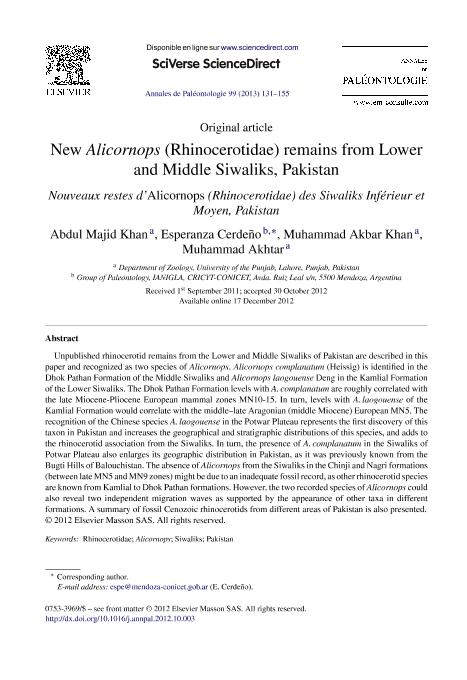Artículo
Unpublished rhinocerotid remains from the Lower and Middle Siwaliks of Pakistan are described in this paper and recognized as two species of Alicornops. Alicornops complanatum (Heissig) is identified in the Dhok Pathan Formation of the Middle Siwaliks and Alicornops laogouense Deng in the Kamlial Formation of the Lower Siwaliks. The Dhok Pathan Formation levels with A. complanatum are roughly correlated with the late Miocene-Pliocene European mammal zones MN10-15. In turn, levels with A. laogouenseof the Kamlial Formation would correlate with the middle–late Aragonian (middle Miocene) European MN5. The recognition of the Chinese species A. laogouense in the Potwar Plateau represents the first discovery of this taxon in Pakistan and increases the geographical and stratigraphic distributions of this species, and adds to the rhinocerotid association from the Siwaliks. In turn, the presence of A. complanatum in the Siwaliks of Potwar Plateau also enlarges its geographic distribution in Pakistan, as it was previously known from the Bugti Hills of Balouchistan. The absence of Alicornops from the Siwaliks in the Chinji and Nagri formations (between late MN5 and MN9 zones) might be due to an inadequate fossil record, as other rhinocerotid species are known from Kamlial to Dhok Pathan formations. However, the two recorded species of Alicornops could also reveal two independent migration waves as supported by the appearance of other taxa in different formations. A summary of fossil Cenozoic rhinocerotids from different areas of Pakistan is also presented. Dans la présente contribution sont décrits et analysés des restes inédits de rhinocérotidés provenant des Siwaliks Inférieur et Moyen du Pakistan. Deux espèces sont reconnues à savoir Alicornops complanatum (Heissig) de la Formation Dhok Pathan des Siwalik Moyen et Alicornops laogouense Deng de la Formation Kamlial des Siwalik Inférieur. Les niveaux de la Formation Dhok Pathan avec A. complanatum permettent sa corrélation avec les unités mammaliennes européennes MN 10-15 du Miocène supérieur au Pliocène. Au même temps, les niveaux avec A. laogouense de la Formation Kamlial correspondent à peu près à l’unité MN5 (Aragonien moyen à supérieur, Miocène moyen) en Europe. La reconnaissance de l’espèce chinoise A. laogouense dans le Plateau de Potwar représente la première découverte de ce taxon au Pakistan, augmente les distributions géographique et stratigraphique de cette espèce et ajoute un nouveau registre aux Rhinocerotidae des Siwalik. D’autre part, la présence d’A. complanatum dans cette région augmente aussi sa distribution au Pakistan, donc elle était connue à Bugti Hills, Balouchistan. L’absence d’Alicornops dans les Siwaliks aux Formations Chinji et Nagri (équivalent aux zones MN 5 à MN 9) pourrait être due à certain biais dans les fouilles, donc autres espèces de rhinocéros sont connues depuis la Formation Kamlial jusqu’à la Formation Dhok Pathan. Cependant, les deux espèces d’Alicornops pourraient rendre évident deux migrations indépendantes tel qu’il est supporté par d’autres taxons dans des formations différentes. Un résumé des rhinocérotidés cénozoïques des différentes régions du Pakistan est aussi présenté.
New Alicornops (Rhinocerotidae) remains from Lower and Middle Siwaliks, Pakistan
Título:
Nouveaux restes d’Alicornops (Rhinocerotidae) des Siwaliks Inférieur et Moyen, Pakistan
Fecha de publicación:
17/12/2012
Editorial:
Elsevier
Revista:
Annales de Paleontologie
ISSN:
0753-3969
Idioma:
Inglés
Tipo de recurso:
Artículo publicado
Clasificación temática:
Resumen
Palabras clave:
Rhinocerotidae
,
Alicornops
,
Siwaliks
,
Pakistan
Archivos asociados
Licencia
Identificadores
Colecciones
Articulos(IANIGLA)
Articulos de INST. ARG. DE NIVOLOGIA, GLACIOLOGIA Y CS. AMBIENT
Articulos de INST. ARG. DE NIVOLOGIA, GLACIOLOGIA Y CS. AMBIENT
Citación
Khan, Abdul Majid; Cerdeño Serrano, Maria Esperanza; Khan, Muhammad Akbar; Akhtar, Muhammad; New Alicornops (Rhinocerotidae) remains from Lower and Middle Siwaliks, Pakistan; Elsevier; Annales de Paleontologie; 99; 2; 17-12-2012; 131-155
Compartir
Altmétricas




